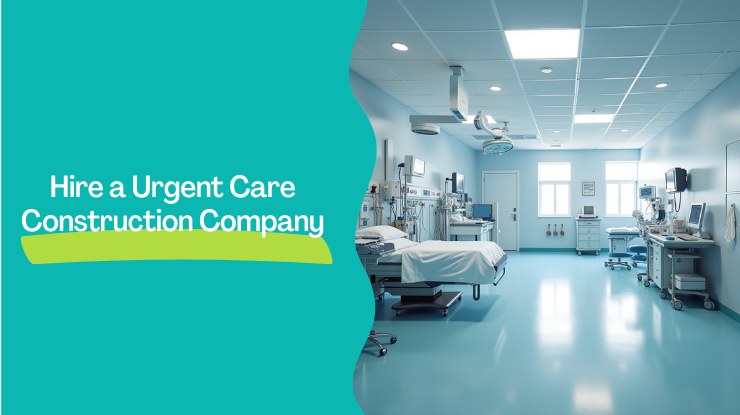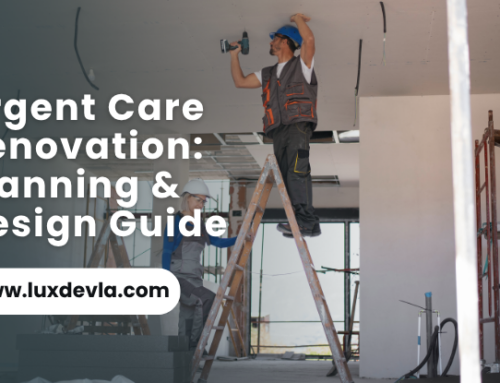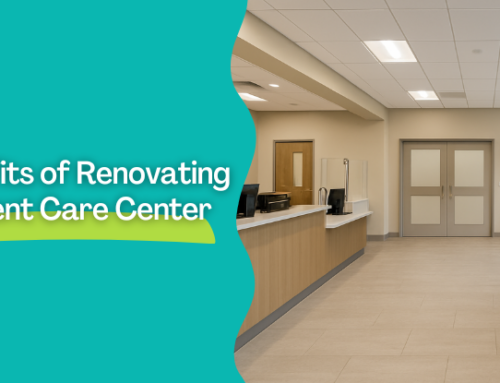Why Building an Urgent Care Center Isn’t Your Average Construction Project.
So, what actually makes urgent care construction more complicated than your typical commercial build?
It comes down to this: you’re not just putting up walls and picking paint colors. You’re building a medical facility—one that needs to check off all the boxes for healthcare regulations, clinical efficiency, and patient safety. That’s where an experienced urgent care construction company steps in—not just to build, but to design with intention.
More and more people are turning to urgent care centers for faster, more convenient treatment. That shift means there’s a higher demand for spaces that work like hospitals—but feel less overwhelming. But here’s the catch: these clinics still need to follow serious rules like ADA compliance, HIPAA privacy regulations, and infection control protocols. On top of that, the facility has to support everything from oxygen line installations to EHR (Electronic Health Record) compatibility.
This isn’t something a general contractor can guess their way through.
Companies like Lux Construction Group, who specialize in healthcare builds, understand that urgency doesn’t stop at the front desk. They help healthcare providers, developers, and clinic operators bring projects to life—on time, on budget, and fully compliant with local health department and federal guidelines.
Want to see how we’ve done it before? Check out our recent projects in our portfolio
Before you dive into your next build, here’s something worth thinking about: not all construction companies are built for healthcare.
We’ll walk you through five eye-opening reasons why choosing a company that actually understands urgent care construction can make or break your project.
Some of these might not be what you expect—but they could save you serious time, money, and frustration. Keep reading.
Contents
- Reasons to Hire a Construction Company for Your Urgent Care Facility
- 1. Navigating Complex Healthcare Regulations & Compliance
- 2. Expertise in Urgent Care Workflow & Space Planning
- 3. Mastery of Specialized Medical Infrastructure
- 4. Built-In Infection Control During & Post Construction
- 5. Efficient Project Management & Speed to Market
- Partner with a Trusted Urgent Care Construction Company
Reasons to Hire a Construction Company for Your Urgent Care Facility
Constructing an urgent care facility is not merely about bricks and mortar; it’s about weaving through a labyrinth of healthcare-specific regulations that ensure patient safety, accessibility, and operational efficiency.
In California, this complexity is amplified by stringent state and local codes that govern healthcare construction.
Key Regulatory Frameworks:
- California Building Standards Code (Title 24): This comprehensive code encompasses various aspects of construction, including structural, electrical, mechanical, and plumbing systems.
For healthcare facilities, specific provisions under Title 24 address the unique requirements of medical environments. - OSHPD 3 Requirements: The Office of Statewide Health Planning and Development (OSHPD) outlines specific standards for clinics, known as OSHPD 3. These standards ensure that outpatient facilities meet safety and operational criteria essential for patient care.
- Los Angeles Building Code: In addition to state regulations, the City of Los Angeles enforces its own building codes, which may include more stringent requirements for healthcare facilities, such as enhanced seismic standards and accessibility features.
Lux Construction Group have a deep understanding of these regulations and the experience to navigate the permitting and inspection processes efficiently. They can anticipate potential compliance issues and address them proactively, reducing the risk of costly delays or modifications.
Understanding and adhering to complex regulations is just the beginning. Equally important is designing a facility that supports efficient patient flow and staff operations.
Let’s explore how specialized knowledge in healthcare space planning plays a crucial role in the success of urgent care center.
2. Expertise in Urgent Care Workflow & Space Planning
Designing an urgent care facility is all about creating a space that enhances efficiency, reduces patient wait times, and improves overall satisfaction. Specialized construction companies like ours understand the intricacies of healthcare workflows and can design spaces that optimize patient flow and staff operations.
Key Considerations:
- Efficient Patient Flow: A well-designed layout minimizes unnecessary movement, allowing patients to move seamlessly from check-in to consultation rooms.
- Staff Efficiency: Proper space planning reduces staff fatigue and improves communication, leading to better patient care.
- Patient Satisfaction: Efficient layouts contribute to shorter wait times and a more comfortable patient experience.
A study highlighted that optimizing patient flow in urgent care centers can significantly reduce wait times. For instance, implementing digital tools for patient history recording during triage led to a 26.17% decrease in average wait times with just a 2.5-minute time saving per patient.
While efficient space planning is crucial, integrating specialized medical systems and infrastructure is equally important.
Let’s delve into how expertise in this area ensures the functionality and safety of urgent care facilities.
3. Mastery of Specialized Medical Infrastructure
Constructing an urgent care facility requires more than just general building expertise; it necessitates a deep understanding of specialized medical infrastructure to ensure patient safety, regulatory compliance, and operational efficiency.
Key Components:
- Medical Gas Systems: Installation of medical gas systems, including oxygen, nitrous oxide, and vacuum lines, is critical for patient care.
Proper design and installation are essential to meet safety standards and ensure reliable operation. - HVAC Systems: Healthcare facilities demand HVAC systems that maintain strict temperature and humidity controls, as well as proper air filtration, to prevent the spread of infections and ensure patient comfort.
- Electrical and IT Infrastructure: Robust electrical systems are necessary to support medical equipment, while integrated IT infrastructure ensures seamless operation of electronic health records (EHR) and other digital tools.
A study highlighted that healthcare infrastructure is a key pillar supporting improved standards of care and patient wellbeing. Properly designed and implemented medical infrastructure directly contributes to better patient outcomes and more efficient healthcare delivery.
While specialized infrastructure is vital, maintaining a sterile environment is equally crucial.
4. Built-In Infection Control During & Post Construction
Infection control is a paramount concern in healthcare facility construction, particularly for urgent care centers that cater to patients with varying degrees of illness.
Implementing rigorous infection prevention measures during and after construction is essential to ensure patient safety and regulatory compliance.
Key Infection Control Measures:
- Infection Control Risk Assessment (ICRA): An ICRA is a critical component of healthcare construction planning. It involves identifying potential infection risks associated with construction activities and implementing appropriate mitigation strategies.
The American Society for Health Care Engineering (ASHE) provides comprehensive guidelines for conducting ICRAs, emphasizing the importance of interdisciplinary collaboration to enhance infection prevention during construction projects.
- Negative Air Pressure and Containment: Establishing negative air pressure environments in construction zones helps prevent the spread of airborne contaminants to adjacent patient care areas.
Proper containment measures, such as sealed barriers and HEPA filtration systems, are essential to maintain a sterile environment during construction.
- Material Selection and Surface Finishes: Choosing appropriate materials and finishes that are easy to clean and resistant to microbial growth is vital.
While infection control is crucial, ensuring that the construction process is efficient and timely is equally important.
Let’s explore how specialized project management contributes to the swift and successful completion of urgent care facilities.
5. Efficient Project Management & Speed to Market
In the competitive landscape of healthcare, the ability to bring an urgent care facility to market swiftly can significantly impact patient access and revenue generation. Delays in construction not only escalate costs but also postpone the delivery of essential healthcare services to communities in need.
Key Strategies for Accelerated Delivery:
- Modular Construction: Utilizing prefabricated modules can drastically reduce construction timelines. By assembling components off-site and installing them on-site, projects can achieve faster completion without compromising quality.
- Integrated Project Delivery (IPD): This collaborative approach brings together stakeholders—owners, designers, and builders—early in the project, fostering transparency and joint decision-making, which accelerates project timelines.
- Fast-Track Construction: Overlapping design and construction phases allow for earlier project initiation, reducing the overall schedule. However, this method requires meticulous planning and coordination to manage risks effectively.
Having explored the five strategic reasons to hire a specialized construction company for urgent care facilities, it’s evident that expertise in compliance, design, infrastructure, infection control, and project management is crucial.
Partner with a Trusted Urgent Care Construction Company
Building an urgent care facility isn’t just about putting up walls—it’s about making a smart investment in the future of community care. From staying compliant with healthcare regulations to designing for smooth patient flow, installing the right medical infrastructure, and keeping infection risks under control, every piece of the puzzle matters.
In a city like Los Angeles, where healthcare needs are growing and evolving fast, choosing the right construction partner can make all the difference. With over 35 years of hands-on experience, Lux Construction Group specializes in building urgent care facilities that check every box: compliant, efficient, patient-centered, and ready for what’s next in healthcare delivery.






